Chapter 03 Mindful Eating: A Path to a Healthy Body Solutions
November 5, 2024Chapter 05 Measurement of Length and Motion Solutions
November 5, 2024Chapter 04 Exploring Magnets Text Book Solutions
Let us enhance our learning
1. Fill in the blanks
(i) Unlike poles of two magnets _______ each other, whereas like poles _______ each other.
Ans: Unlike poles of two magnets attract each other, whereas like poles repel each other.
(ii) The materials that are attracted towards a magnet are called _______.
Ans: The materials that are attracted towards a magnet are called magnetic materials.
(iii) The needle of a magnetic compass rests along the n_______ direction.
Ans: The needle of a magnetic compass rests along the north-south direction.
(iv) A magnet always has two _______.
Ans: A magnet always has two poles.
Q2: State whether the following statements are True (T) or False (F).
(i) A magnet can be broken into pieces to obtain a single pole.
Ans: False
(ii) Similar poles of a magnet repel each other.
Ans: True
(iii) Iron filings mostly stick in the middle of a bar magnet when it is brought near them.
Ans: False
(iv) A freely suspended bar magnet always aligns with the north-south direction.
Ans: True
Q3: Column I shows different positions in which one pole of a magnet is placed near that of the other. Column II indicates the resulting interaction between them for different situations. Fill in the blanks.
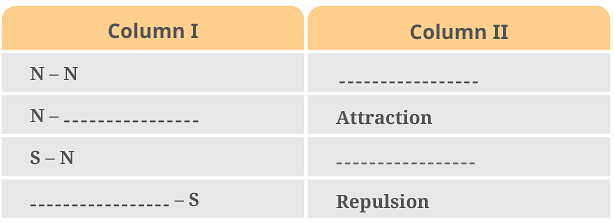
Ans:
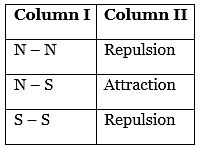
Q4: Atharv performed an experiment in which he took a bar magnet and rolled it over a heap of steel U-clips. According to you, which of the options given in Table 4.3 is to be his observation likely?
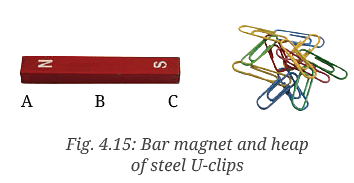
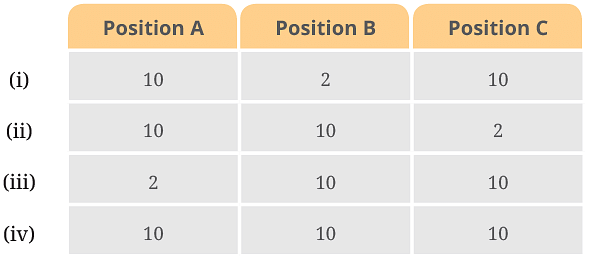 Table 4.3: Number of pins attracted by the magnet at its various positions
Table 4.3: Number of pins attracted by the magnet at its various positions
Ans:

Q5: Reshma bought three identical metal bars from the market. Out of these bars, two were magnets and one was just a piece of iron. How will she identify which two amongst the three could be magnets (without using any other material)?
Ans: Reshma can bring one metal bar close to the other two bars one by one. If it repels either of the two, then it is a magnet and the bar that it repels is also a magnet. The one which does not repel but only attracts is the piece of iron.
Q6: You are given a magnet which does not have the poles marked. How can you find its poles with the help of another magnet which has its poles marked?
Ans: Reshma can suspend the unmarked magnet freely and allow it to align itself in the north-south direction. The end that points towards the north is the North pole, and the end pointing towards the south is the South pole. Alternatively, she can use another marked magnet and bring its North pole close to one end of the unmarked magnet. If there is attraction, then that end of the unmarked magnet is the South pole.
Q7: A bar magnet has no markings to indicate its poles. How would you find out near which end its North pole is located without using another magnet?
Ans: Suspend the magnet freely and let it align in the north-south direction. The end pointing towards the north direction is the North pole of the magnet.
Q8: If the earth is itself a magnet, can you guess the poles of earth’s magnet by looking at the direction of the magnetic compass?
Ans: Yes, the end of the compass needle that points towards the North direction is the North-seeking pole, which means the geographic North pole of the Earth is actually the magnetic South pole, and the geographic South pole of the Earth is the magnetic North pole.
Q9: While a mechanic was repairing a gadget using a screwdriver, the steel screws kept falling down. Suggest a way to solve the problem of the mechanic on the basis of what you have learnt in this chapter.
Ans: The mechanic can magnetize the screwdriver by stroking it with a magnet several times. This will make the screwdriver attract the steel screws, preventing them from falling down.
Q10: Two ring magnets X and Y are arranged as shown in Fig. 4.16. It is observed that the magnet X does not move down further. What could be the possible reason? Suggest a way to bring the magnet X in contact with magnet Y, without pushing either of the magnets.
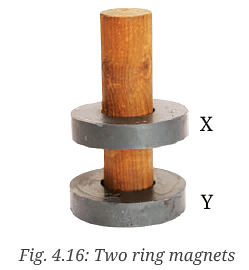
Ans: The possible reason is that like poles of the magnets X and Y are facing each other, causing repulsion. To bring magnet X in contact with magnet Y, flip magnet Y so that unlike poles face each other, resulting in attraction.
Q11: Three magnets are arranged on a table in the form of the shape shown in Fig. 4.17. What is the polarity, N or S, at the ends 1, 2, 3, 4 and 6 of the magnets? Polarity of one end (5) is given for you.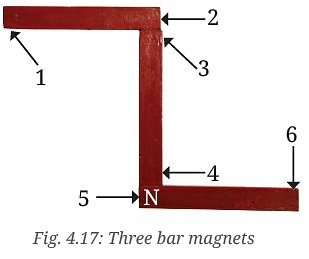 Ans:
Ans:
End 1: South (S)
End 2: North (N)
End 3: South (S)
End 4: North (N)
End 6: North (N)
Learning further
Q12: Using 3–4 different magnets, try to lift steel pins or U-clips and check which magnet picks up the largest number of pins. Discuss with your friends why different magnets might have picked up different numbers of pins.
Ans: Different magnets may have varying strengths based on their material, size, and shape. This affects their magnetic field and, consequently, their ability to lift steel pins or U-clips.
Q13: Make a toy ‘Hopping Frog’ as a combined class activity with the help of your
teacher. For constructing the toy, fix ring magnets in an alternate North-South fashion along the length of a scale using glue (Fig. 4.18a). Paint a frog on paper, cut along the outline and glue a ring magnet at its base. Take a transparent, flexible plastic strip (Fig. 4.18a) of a smaller size and glue it to the ring magnet which is attached to the frog.
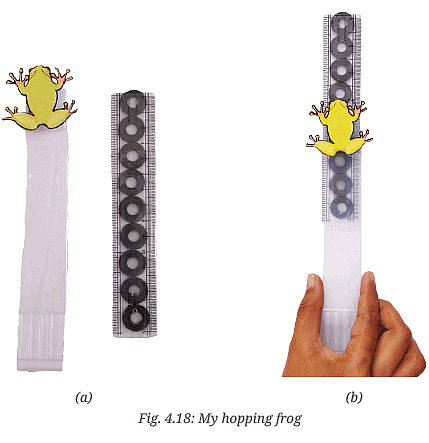
Ans: When you slide the plastic strip (with frog) over the scale (Fig. 4.18b), you can observe the frog hopping.
Q14: Find out about the Maglev Train and try to make its model.
Ans: Maglev trains use powerful magnets to levitate above the tracks, reducing friction and allowing for high-speed travel. Use magnets and a small model to demonstrate this concept.
Q15: Try to find out why there is a need to make magnets of different shapes.
Ans: Magnets of different shapes are needed to fit various applications, such as in motors, speakers, sensors, and toys, where specific magnetic fields and geometries are required.
Q16: Collect information related to the use of magnets in the field of medicine.
Ans: Magnets are used in medicine for MRI machines, which create detailed images of the inside of the body. They are also used in magnetotherapy for pain relief and in magnetic implants for various medical devices.

